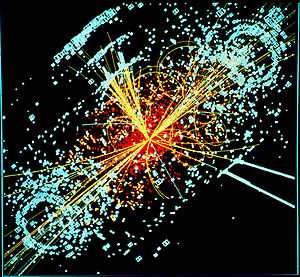Shape dynamics
| Beyond the Standard Model |
|---|
 Simulated Large Hadron Collider CMS particle detector data depicting a Higgs boson produced by colliding protons decaying into hadron jets and electrons |
| Standard Model |
In theoretical physics Shape Dynamics is a theory of gravity that implements Mach's principle. Shape dynamics is dynamically equivalent to the canonical formulation of General Relativity, known as ADM formalism. Shape dynamics is not formulated as an implementation of spacetime diffeomorphism invariance, but as an implementation of spatial relationalism based spatial diffeomorphism- and spatial Weyl symmetry.[1] An important consequence of shape dynamics the absence of a problem of time in canonical quantum gravity.[2] The replacement of the spacetime picture with a picture of evolving spatial conformal geometry opens the door for a number of new approaches to quantum gravity.[3]
Background
Mach's principle has been an important inspiration for the construction of general relativity, but the physical interpretation of Einstein's formulation of general relativity still requires external clocks and rods and thus fails to be manifestly relational.[4] Mach's principle would be fully implemented if the predictions of general relativity were independent of the choice of clocks and rods. Barbour and Bertotti conjectured that Jacobi's principle and a mechanism they called best matching were construction principles for a fully Machian theory.[5] Barbour implemented these principles in collaboration with Niall O Murchadha, Edward Anderson, Brendan Foster and Bryan Kelleher to derive the ADM formalism in constant mean curvature gauge.[6] This did not implement Mach's principle, because the predictions of general relativity in constant mean curvature gauge depend on the choice of clocks and rods. Mach's principle was successfully implemented by a young group around Perimeter Institute researcher Tim Koslowski.[7]
Relation with general relativity
Shape dynamics possesses the same dynamics as general relativity, but has different gauge orbits.[8] The link between general relativity and shape dynamics can be established using the ADM formalism in the following way: Shape dynamics can be gauge fixed in such a way that its initial value problem and its equations of motion coincide with the initial value problem and equations of motion of the ADM formalism in constant mean extrinsic curvature gauge. This equivalence ensures that classical Shape Dynamics and classical General Relativity are locally indistinguishable. However, there is the possibility for global differences.[9]
Problem of Time in Shape Dynamics
The Shape Dynamics Formulation of gravity possesses a physical Hamiltonian that generates evolution of spatial conformal geometry. This disentangles the problem of time in quantum gravity: The gauge problem (the choice of foliation in the spacetime description) is replaced by the problem of finding spatial conformal geometries, leaving an evolution that is comparable to a system with time dependent Hamiltonian.[10] The problem of time is suggested to be completely solved by restricting oneself to "objective observables," which are those observables that do not depend on any external clock or rod.[11]
References
- ↑ Barbour, Julian (2012). "Gravity as Machian Shape Dynamics". fqxi talk.
- ↑ Koslowski, Tim. "Tim Koslowski's homepage". Retrieved 2012-11-18.
- ↑ Koslowski, Tim (2013). Shape Dynamics and Effective Field Theory.
- ↑ Merali, Zeeya (2012). "Is Einstein's Greatest Work All Wrong—Because He Didn't Go Far Enough?". Discover magazine. Retrieved 4-10-2012.
- ↑ Barbour, Julian; Bertotti, Bruno (1982). "Mach’s principle and the structure of dynamical theories". Proceedings of the Royal Society A 382.
- ↑ Anderson, Edward; Barbour, Julian; Foster, Brendan; Kelleher, Bryan; O Murchadha, Niall (2005). "The physical gravitational degrees of freedom". Classical and Quantum Gravity 22.
- ↑ Perimeter Institute (2011). "What if size really doesn't matter?". annual report 2011.
- ↑ Gomes, Henrique; Koslowski, Tim (2012). "The Link between General Relativity and Shape Dynamics". Classical and Quantum Gravity 29 (7). doi:10.1088/0264-9381/29/7/075009.
- ↑ Gomes, Henrique; Koslowski, Tim (2012). Frequently asked questions about Shape Dynamicss.
- ↑ Koslowski, Tim (2012). Observable Equivalence between General Relativity and Shape Dynamics.
- ↑ Barbour, Julian; Koslowski, Tim; Mercati, Flavio (2013). The solution to the problem of time in Shape Dynamics.